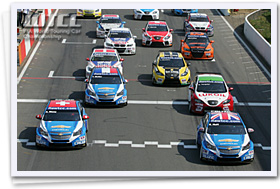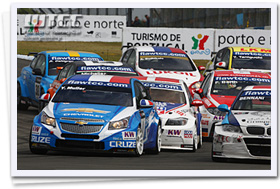
This year the FIA World Touring Car Championship (WTCC) has reached its eighth season since its inauguration in 2005. It was founded as one of FIA's only three world championships along with the much older Formula One and World Rally Championship, although FIA later added two more, the FIA GT1 World Championship and the FIA World Endurance Championship. In the motor sport hierarchy, these FIA championships are always regarded as the pinnacles of each category, WTCC is therefore ranked as the highest level of touring car sprint race series.
The race format of a WTCC event remains the same since the first season. On Saturday, two 30 minute practice sessions are held before a 30 minute qualifying session with exceptions for temporary street tracks. Then there is a 15 minute warm up session on Sunday morning and two final races follow with a certain time interval between them.
In addition, an official test session is to be held on Friday for the events in Italy, Morocco, Brazil, America, Japan and China, and on Thursday in Macau, of the race weeks. The sessions are 30 minutes long but, for the Italian round, two one hour sessions are given to the teams as it is the first race of the season.
The main appeal of WTCC events are breathtaking close battles from start to finish in both two final races. And one of the main factors which creates this is the so-called reverse grids system.
The qualifying session on Saturday consists of two sections: Qualifying 1 and Qualifying 2 - abbreviated as Q1 and Q2. Q1 is the first 20 minutes (30 minutes for street tracks) of the session in which all competitors run to qualify.

Then only the top 12 drivers in Q1 are allowed to continue in remaining 10 minutes (15 for street tracks) Q2 section and try to get a better starting position within the top 12 grids. Until the last season, the top 10 drivers went on to Q2 but two more slots are added this year.
The starting grids for the first race - Race 1 - are decided by the qualifying order in Q2 and, for the drivers in 13th or lower, the order in Q1 are applied. The top 12 grids for Race 2 are, however, arranged as the diagram below, according to the reverse grid rules. The competitors aren't allowed to add or reduce the amount of fuel onboard between Q1 and Q2.
As has been in the past seasons, the two final races get underway with different starting procedures, a rolling start for Race 1 and a standing start for Race 2. Rear wheel drive cars have a slight advantage in a standing start - that's why two different ways to start are employed - and they often make a great getaway on their way to the first corner.
As another tweak in the event format, the race distance is now extended a little for 2012 and it shall be between 50km and 60km per race, while it had been stipulated as 50km or less until last year.